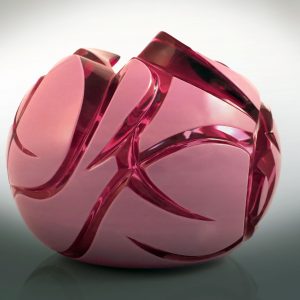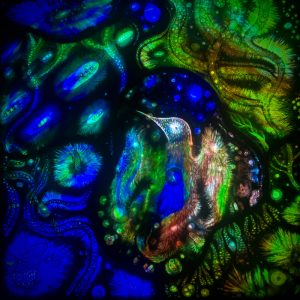2024
NEW ACQUISITIONS 2023

NEW ACQUISITIONS 2023
The current exhibition “New Acquisitions 2023” will be extended until June 2nd, 2024!
This past year, we once again searched high and low across the German and international glass scene to find exciting glass art to enrich the Ernsting Foundation’s collection. Our trips to exhibitions, trade fairs, galleries and artists’ studios were a great success, as the glass art we encountered there was bursting with creativity and professionalism. We were presented with a colourful and wide-ranging palette of diverse works, from polychrome to purist, from fragile to compact, from refreshingly whimsical to socially critical, from lively narrative art to serene aesthetics.
Among these gems, we discovered two award-winning oeuvres: At the renowned Galerie Handwerk in Munich, we were introduced to the work of artists including the very young, extremely talented Anna Martinková from the Czech Republic. Born in Prague in 2001, she is currently still studying at that city’s Academy of Art, Architecture and Design. We are evidently not the only ones to be impressed by the clear yet extraordinary geometry of her design language, as she was recently awarded the highly regarded “Czech International Student Design 2023 – Outstanding Student Design Award” for her piece “Holy water font”. Made of moulded, precisely cut and polished glass, it represents a holy water font as indicated by the title, but its shape is atypical, echoing the unusual floor plan of the Baroque Gothic St. Anne’s Chapel in the Czech town of Panenské Břežany. Anna Martinková thus not only pays tribute here to the idiosyncratic architecture of the Bohemian Baroque Gothic style but also deftly straddles the border between fine and applied art.
Works by the artist Desislava Stoilova also caught our eye in Munich. She was born in Bulgaria in 1983 and has been living and working in France for many years. Her preferred material is pâte de verre, an opaque glass paste, which she fires in a sand mould in the kiln. Stoilova’s sculpture “Waiting for the Rain” was awarded a Silver Prize at the esteemed “International Exhibition of Glass Kanazawa 2022” in Japan. Despite or perhaps because of its soft, translucent hues, the work exudes not only graceful fragility but also strength and calm. Desislava Stoilova says of her practice: “The rough and irregular texture of glass evokes the passage of time and the resulting wear and tear on materials. I am inspired by the transformation of the material but also of reality and memory.”
At an exhibition at the Gernheim glassworks we discovered, among other things, works by Anne Wenzel, one of the few remaining German master engravers. She is also a fabulous storyteller who translates her multi-layered, often bizarre tales with the help of a fantastical visual language directly into the coloured flashed glass she likes to work with.
You can now look forward to enjoying 60 or so exquisite new acquisitions by artists from all over the world, including objects, sculptures and installations, in our latest exhibition!
Photo above: Valerie Rey, RESPECT, 2022 – Photo Valerie Rey
Photos from left:
Jenny Mulligan, Confluence Pinky, 2023 – Photo Jenny Mulligan
Nina Casson McGarva, Iris, 2023 – Photo Nina Casson McGarva
Anna Martinková, Holy water font, 2022 – Photo Šimona Němečková
Martin Janecký, Thinker (Blue), 2023 – Photo Glasmuseum Lette
Anne Wenzel, Skin Food, 2022 – Photo Julius Demant
Desislava Stoilova, Waiting for the Rain, 2021 – Photo Desislava Stoilova
Rayleen Clancy, In the Hollow Rocks, 2022 – Photo Rayleen Clancy
Karin Mørch, Big Line, Dark Green, 2022 – Photo Ole Akhøj
Franz Winkelkotte, Offene Gesellschaft, 2023 – Photo Ralf Emmerich
Nancy Sutcliffe, Colony, 2022 – Photo Nancy Sutcliffe
Pauline Bétin, Cereal Catedral, 2017 – Photo Pauline Bétin
Rasmus Nossbring, Faint Recall, 2023 – Photo Studio Kleiner














